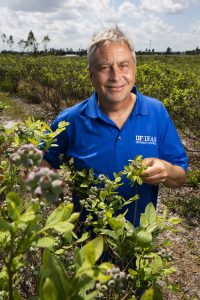March brings the start of Florida’s blueberry production, harvest and shipping season. The state’s blueberry industry has grown rapidly in the past 20 years. Today, Florida farmers grow more than 5,200 acres of blueberries, producing about 20 million pounds.
Dating back to the 1950s, with a history of developing good-tasting, disease- and pest-resistant varieties, UF/IFAS’ blueberry breeding program released its latest cultivar, ‘Sentinel,’ in 2020. So far, ‘Sentinel’ brings high yields for growers and fruit that is liked by consumers, as reflected in UF Sensory Lab consumer taste panels.
We met with Doug Phillips, the UF/IFAS statewide blueberry Extension coordinator, to see what we can expect from the blueberry market this year.
Q: In addition to ‘Sentinel,’ what are some the latest blueberry varieties from UF/IFAS? What makes them interesting to the consumer? How about for the producer?
A: More recent UF/IFAS releases include ‘Optimus.’ Machines pick it very well, and it has firm, sweet fruit. Others include ‘Arcadia’ and ‘Avanti’ for the evergreen system; ‘Colossus’ for north-central and central Florida; and ‘Magnus,’ which is best suited for north-central Florida. Detailed information, including yield, fruit quality data and other material is available here and in the UF/IFAS Blueberry Growers Guide app.

Q: When is it best for commercial growers to plant their blueberries and why?
A: It is best to plant blueberries during the cooler portions of the year, before or after summer high temperatures. In Florida, blueberries are harvested beginning in March in south-central and central Florida and ending typically by early May, when market prices begin to drop and much of the available fruit has been harvested. If planted before summer, and the cultivar selected is vigorous enough, then fruit could be harvested the following season, which will not be the case if planting after summer. However, Florida blueberry growers plant at different times during the year, depending on weather, temperatures, plant availability, labor availability for bed preparation and planting and availability of water for irrigation.
Q: Where do blueberries grow in Florida?
A: Blueberries grow throughout the state of Florida, primarily from Hendry County in the south to Alachua and Putnam counties in the north. There are some rabbiteye blueberries grown in the Florida Panhandle, mostly on smaller farms with U-pick operations. Most blueberries grow in central Florida, although there is significant acreage in both the north-central and south-central regions.
Q: Where does Florida rank in blueberry production nationally?
A: Based on 2019 U.S. Department of Agriculture data, Florida ranked eighth in terms of utilized blueberry production. We are not very large, but we do produce the first fresh fruit of the country and that makes us very relevant.
Q: What considerations must commercial blueberry growers consider when growing blueberries?
A: The primary categories blueberry growers must consider include which cultivars will perform best in their location, diseases, insect and mite pests, weed control, choice of production system (deciduous vs. evergreen), proper fertilization and irrigation, pollination resources, pruning, freeze protection and harvest labor availability and pricing. We at UF/IFAS conduct a survey and meet individually with growers every year to inform them about recent updates for many of these factors.
Q: How do growers cope/manage those potential obstacles/challenges?
A: While large companies might dedicate entire teams focused on each area, most Florida producers rely on the information and support given by UF/IFAS. UF/IFAS has several production resources available to commercial blueberry growers, including multiple EDIS publications addressing many of the items. Links can be found at https://www.blueberrybreeding.com/blog, and the UF/IFAS Blueberry Growers Guide app (available for both iOS and Android systems), which includes a scouting guide, monthly management calendar for Florida growers, and a cultivars module with detailed information on UF/IFAS southern highbush blueberry releases. In addition, I can answer growers’ questions, and I am a liaison with UF/IFAS faculty.
Q: What are the current market conditions for Florida blueberry producers?
A: Florida has the first U.S.-produced blueberries to reach the domestic market in early spring. Harvest generally begins in March in the south-central and central regions and continues through early May, when market prices decline. This market window is when prices are typically the highest, which is an advantage for Florida growers.
Q: How has blueberry breeding changed over the years?
A: Historically, blueberry breeding has involved a method called recurrent phenotypic selection, where parents with favorable characteristics are crossed and over time, offspring with the most favorable characteristics are selected to advance through a multi-stage selection process. Some of these favorable offspring are also used as parents in subsequent breeding cycles, with the goal of continually increasing the favorable characteristics of the breeding program’s germplasm. This process works well but could take 12 to 15 years – and a lot of resources — to develop a new cultivar. In more recent years, different strategies, methods and techniques have been implemented in breeding programs to accelerate the process of identification of superior parents and individuals that can become cultivars. One of these is Genomic Selection, a method that uses genetic markers and statistical methods. The process of developing a cultivar is still long, as we still need to test the candidates in multiple commercial locations and management practices, but now it can take us six to 10 years.
-30-
The mission of the University of Florida Institute of Food and Agricultural Sciences (UF/IFAS) is to develop knowledge relevant to agricultural, human and natural resources and to make that knowledge available to sustain and enhance the quality of human life. With more than a dozen research facilities, 67 county Extension offices, and award-winning students and faculty in the UF College of Agricultural and Life Sciences, UF/IFAS brings science-based solutions to the state’s agricultural and natural resources industries, and all Florida residents.
ifas.ufl.edu | @UF_IFAS
 2
2
